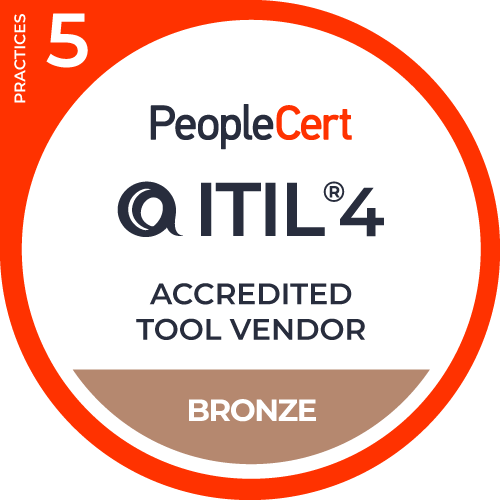IT Asset Management (ITAM)
A Definitive Guide
IT Asset Management (ITAM) is the process of planning and managing the full lifecycle of all IT assets. In other words, it’s the framework that allows organizations to keep track of all their software and hardware from acquisition to disposal, ensuring that nothing falls through the cracks and that they don’t waste money in the meantime.
Even though ITAM has been neglected within IT Service Management (ITSM), its adoption has grown in popularity in recent years, with IT organizations finally waking up to the fact that they have asset-based waste. In fact, the ITAM software market was valued at USD 6.60 billion in 2022, with an estimated compound annual growth rate of 7.91% anticipated during the forecast period spanning from 2023 to 2030. As per projections, this sector is expected to reach a value of USD 12.14 billion by the end of the forecast period.
We created this definitive guide to help you catch the wave and enjoy all the benefits ITAM can bring to your organization. Keep reading to discover more about the IT Asset Management framework, its relation to ITSM, processes, best practices, and implementation tools.
What is IT Asset Management (ITAM)?
Let’s start by expanding on the definition of ITAM. As we mentioned, IT Asset Management is the practice of managing an organization’s information technology assets throughout their entire lifecycle, from acquisition to disposal.
The primary goal of ITAM is to optimize the value of an organization’s IT investments, while minimizing the risks associated with their use. ITIL - the most popular body of Service Management best practices - states that it serves multiple purposes, including:
- Value maximization.
- Cost control.
- Risk Management.
- Decision-making support about purchasing, re-using, retiring, and disposing of IT assets.
- Regulatory and contractual compliance.
But before moving on, we need to establish what an asset is in this context.
What is an IT asset?
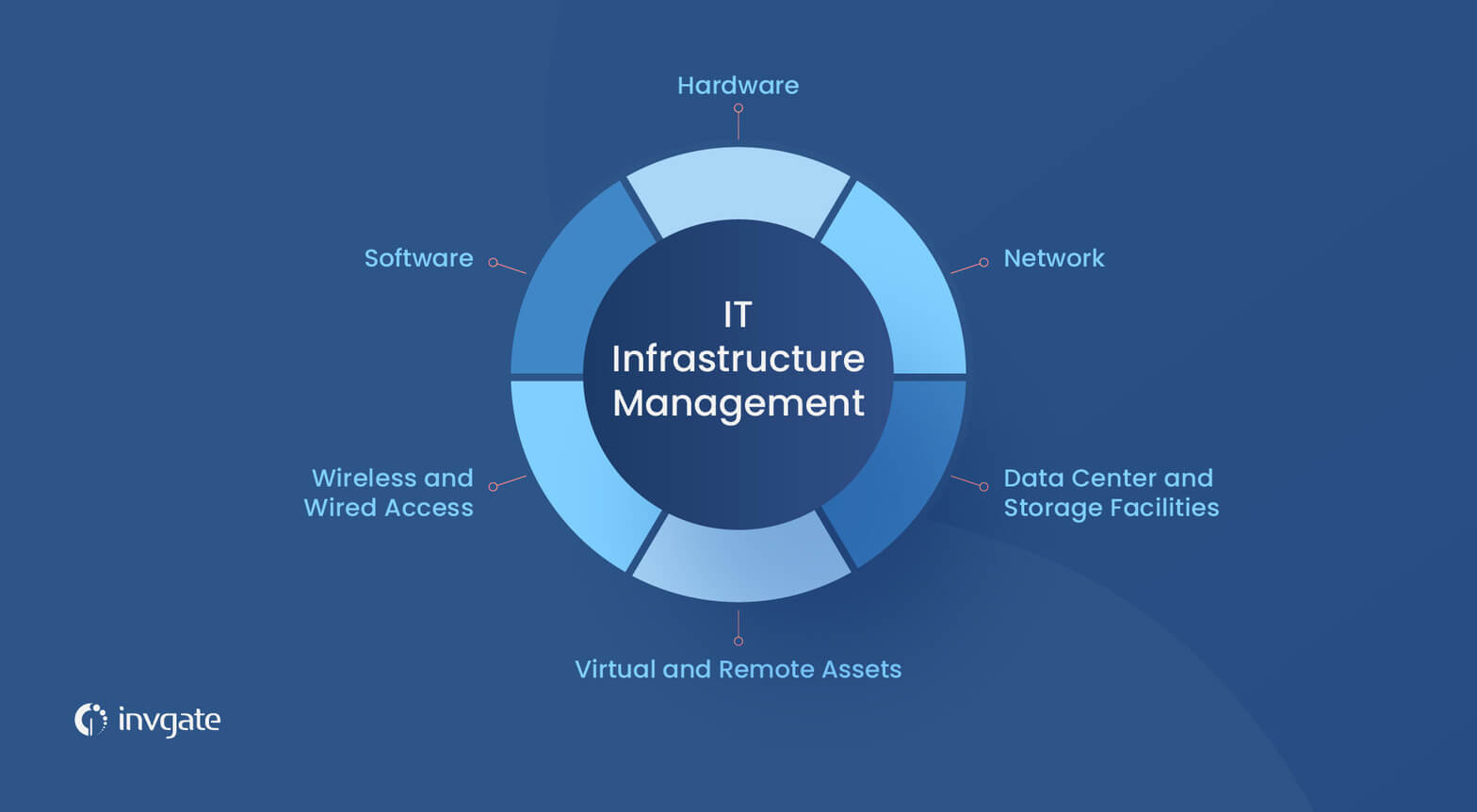
IT assets can be any tangible or intangible resource an organization relies on to support its IT infrastructure and operations. They are technology-related components owned, operated, or managed to support business processes and procedures.
In ITAM, IT assets include:
- Hardware assets - Desktops, laptops, networking equipment, printers and other peripherals, and mobile devices, as well as data center hardware (for example, servers, storage, and uninterruptible power supplies) and network and telecoms equipment (routers, load balancers, switches, and VoIP/videoconferencing equipment).
- Software assets - Software installed on both physical hardware and virtual machines (VMs) across all environments, including operating systems, middleware, server applications, and personal applications.
- Cloud-based assets - Although cloud services are provided and managed by third parties, they also entail customer ITAM obligations and requirements. This type of asset includes software licensing and subscriptions.
- Data assets - Corporate data that needs protection against leaks and cyber attacks, as well as data compliance (particularly relevant when creating an inventory in compliance with the ISO 27001 standard).
The importance of IT Asset Management
There are several reasons for the relevance of IT Asset Management for all companies - whether big organizations or small businesses. For once, it provides them with a single source of truth: a complete, up-to-date IT inventory that allows them to see what they own or lease, the Total Cost of Ownership of their assets, and their current status.
In line with that, implementing an ITAM framework reduces waste - including unnecessary procurement costs, extraneous third-party support and maintenance costs, "shelf-ware," and the internal maintenance of assets that should have been decommissioned. Hence, optimizing the business investments and saving unnecessary bucks spent on vacant software and hardware.
And lastly, it improves productivity and supports all the other ITIL practices, like Incident Management, Problem Management, and Change Management.
ITAM vs. ITSM: What’s the difference?
ITAM and ITSM have traditionally been treated as separate IT management disciplines, but there has always been some overlap. However, in 2019, ITAM was added to the ITIL 4 IT Service Management best practice guidance as one of its 34 management practices.
- Assets generally differ from services (for instance, a desktop PC differs from a managed desktop service).
- Different organizations have traditionally created the bodies of best practice guidance for ITAM and ITSM (until ITIL 4 offered ITAM guidance to Service Management professionals).
- Their goals also differ since ITSM is focused on implementing and managing quality IT services, while ITAM concentrates on controlling the lifecycle of IT assets.
But despite these differences, ITAM and ITSM should be viewed as complementary practices rather than competition - especially because IT services are commonly built from IT assets.
Aligning ITAM with ITSM
In many scenarios, both ITAM and ITSM enhance each other. Thus, even though adopting them as two separate ecosystems is common, it’s better for organizations to plan for and encourage them to work in tandem.
Here are a few examples of how to align ITAM with ITSM:
- Combine IT help desk software with an Asset Management tool to provide your IT support team with centralized information on the organization’s IT state, improving their visibility and productivity.
- ITAM capabilities and data can fulfill several ITSM needs that Service Configuration Management capabilities would not otherwise be able to support.
- Use ITAM data to improve incident resolution times and allow service desk analysts to understand the root cause and potential remedies for an issue more quickly when they have insight into the asset’s details.
- Let employees self-audit their IT assets using the IT self-service portal.
- Leverage ITAM data to help technology refresh projects go more smoothly (mainly if there’s not an effective CMDB in place).
Discover how the Electronic Voting Tech Company Smartmatic streamlined its operations by integrating an ITSM and ITAM solution.
Download Case Study4 benefits of IT Asset Management
For many organizations, the primary motivation for having accurate asset data is financial - reducing asset costs and/or optimizing asset use. However, ITAM has multiple benefits.
1. Unified inventory
One of the most significant benefits of ITAM is that it allows you to have a complete unified IT inventory to see software, hardware, users, locations, and contracts - and even non-IT assets, if you need them! Plus, it never goes out of date (as can quickly occur when using Excel for Asset Management, for instance).
Furthermore, once your IT inventory is up and running, you can build a CMDB to map their relationships. This way, you’ll spot the assets affected in case of downtime, quickly identify the root cause, notify affected users, find workarounds, and ultimately solve the problem in less time.
2. Software license compliance
Mapping your assets can also be helpful to stay compliant with licensing requirements and be ready for software audits. By installing an agent that periodically reports on the software installed in your network devices, you’ll know in real-time the number of licenses in use, which ones are vacant (and if your ITAM tool has Software Metering capabilities, to which extent they’re being used as well).
Plus, if the platform has Contract Lifecycle Management capabilities, you’ll know the license agreement terms and when they’re due. This way, you can set expiration reminders and stay ahead of license renewals, eliminating any risk of fines or penalties.
3. Enhanced security
ITAM can contribute to IT security in two main areas. By regularly monitoring your network, you can detect unauthorized assets and avoid shadow IT. So, you can rest assured that nothing that enters your security perimeter goes unnoticed.
On the other hand, ITAM solutions also allow you to establish a Patch Management strategy to deploy patches in time and avoid security breaches.
4. Data-driven decisions
And finally, IT Asset Management provides valuable information to help you make decisions based on data, and not just common sense or gut instinct. All you need to do is choose the ITAM metrics you’re interested in, create dashboards to report in real-time, and automate reports to see your assets’ status in a specific period.
ITAM processes
IT Asset Management can be broken down into two main processes for the multiple IT assets that compose it: Hardware and Software Asset Management. Let’s take a closer look at each of them.
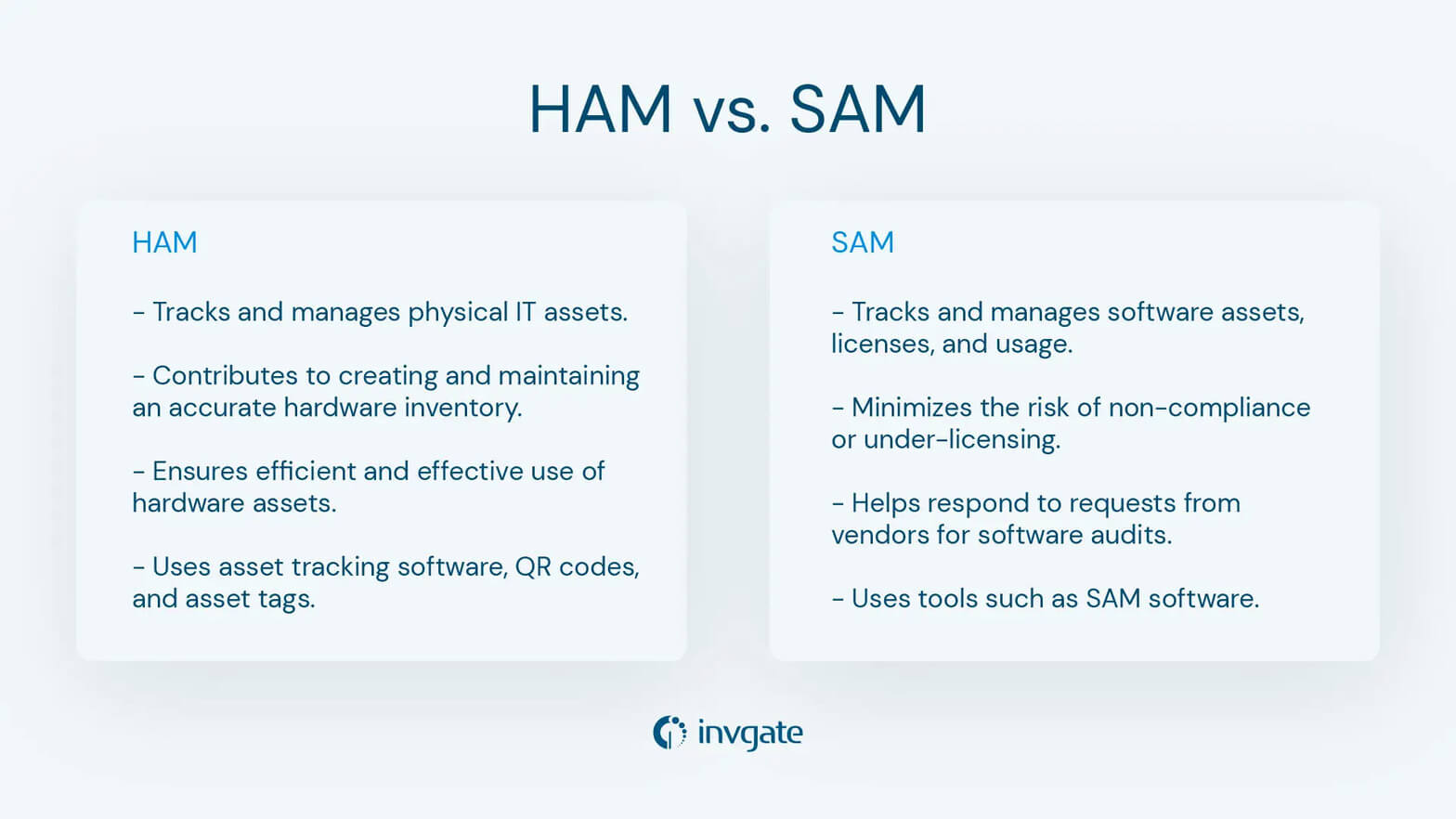
Based on the assessment of your company’s current state, you’ll be able to determine which features are more relevant to you - and whether you need help desk software or maybe it’s time for you to adopt an ITSM approach and opt for a service desk.
Hardware Asset Management (HAM)
As the name indicates, Hardware Asset Management oversees the IT hardware assets. In particular, it monitors all the physical components that constitute your environment during the nine HAM stages.
Software Asset Management (SAM)
Software Asset Management manages the other IT asset universe that forms ITAM: software. Specifically, it addresses the acquisition, development, release, deployment, maintenance, and eventual retirement of software assets.
How to implement an IT Asset Management strategy
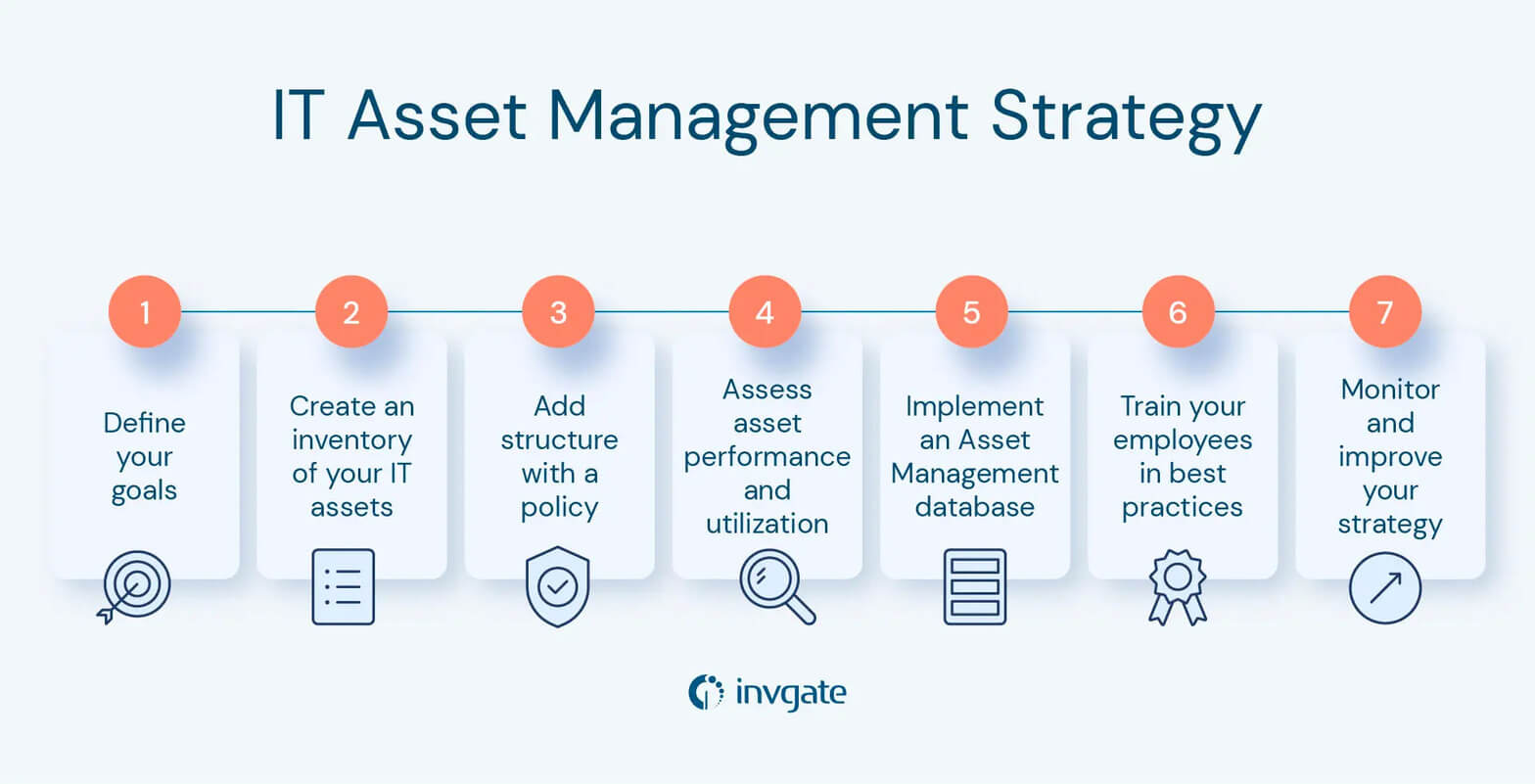
IT Asset Management involves a range of activities, including asset discovery, tracking, and inventory management, as well as planning, procurement, deployment, maintenance, and retirement of IT assets. Moreover, it encompasses a variety of disciplines, such as Financial Management, procurement, software licensing, compliance, security, and Risk Management.
So, you must have an IT Asset Management strategy in place right from the start to coordinate all those different aspects. And to create one, the first thing you need to remember is that, ultimately, ITAM is a proactive practice. You don’t do Asset Management to react to problems once they arise; you do it mainly to stay ahead of them.
All the benefits and capabilities we listed in this guide won’t materialize unless you design and stick to a plan. Now, where to start? A common advice is to start at the beginning, even before you decide to invest in an ITAM tool. It will help determine not only the need for an ITAM tool but also the required capabilities.
The basic steps to develop an ITAM strategy are:
- Understanding your organization’s need for ITAM - Here, it’s essential to appreciate the many roles ITAM capabilities can play and the benefits they bring as a result. This will guide the creation of your ITAM plan, the definition of its goals, and the people/teams you need to involve.
- Agreeing on the initial ITAM scope and focus - Identify what will deliver the best business benefits from the potentially long list of opportunities. For example, suppose your organization is looking to reduce IT asset costs in the short term. For this case, you can use ITAM to prevent expenditure on new assets unless absolutely necessary.
- Pulling together an initial asset inventory - ITAM success will rely on your organization having a centralized trusted source of IT asset information. So, start by finding existing asset inventories/registers. These are likely incomplete and inaccurate, but it’s a good start.
- Creating a policy and establishing defined processes - Give your practice a robust structure to avoid potential confusion, and design the strategies to analyze your assets’ performance and utilization.
- Using agreed-on metrics to measure success - Define the KPIs and the criteria to evaluate the success of your plan according to your initial objectives. This will probably involve things like financial savings, greater efficiency, improved governance and compliance, and improved employee experience and productivity.
- Implementing a culture of continual improvement - ITAM is not something you can implement once and forget forever. In order to truly be proactive, you need to be on top of the data to spot improvement opportunities as soon as they arise.
6 IT Asset Management software must-have features
If you’re convinced to start working on your strategy, the one thing you absolutely need to succeed is IT Asset Management software. As you can imagine, you can’t achieve any of what we just described with a spreadsheet - it’s messy, incomplete, outdated, and lacks automation, among many other drawbacks.
On the contrary, an ITAM solution has the potential to assist you in reconciling licenses with services, enhancing security in your end-user environment, and lowering expenses - but only if it provides you with the right capabilities.
Let’s take a look at the must-have features of ITAM solutions - and don’t forget that, if you need help with the implementation, this ITAM checklist might come in handy!
1. Inventory Management
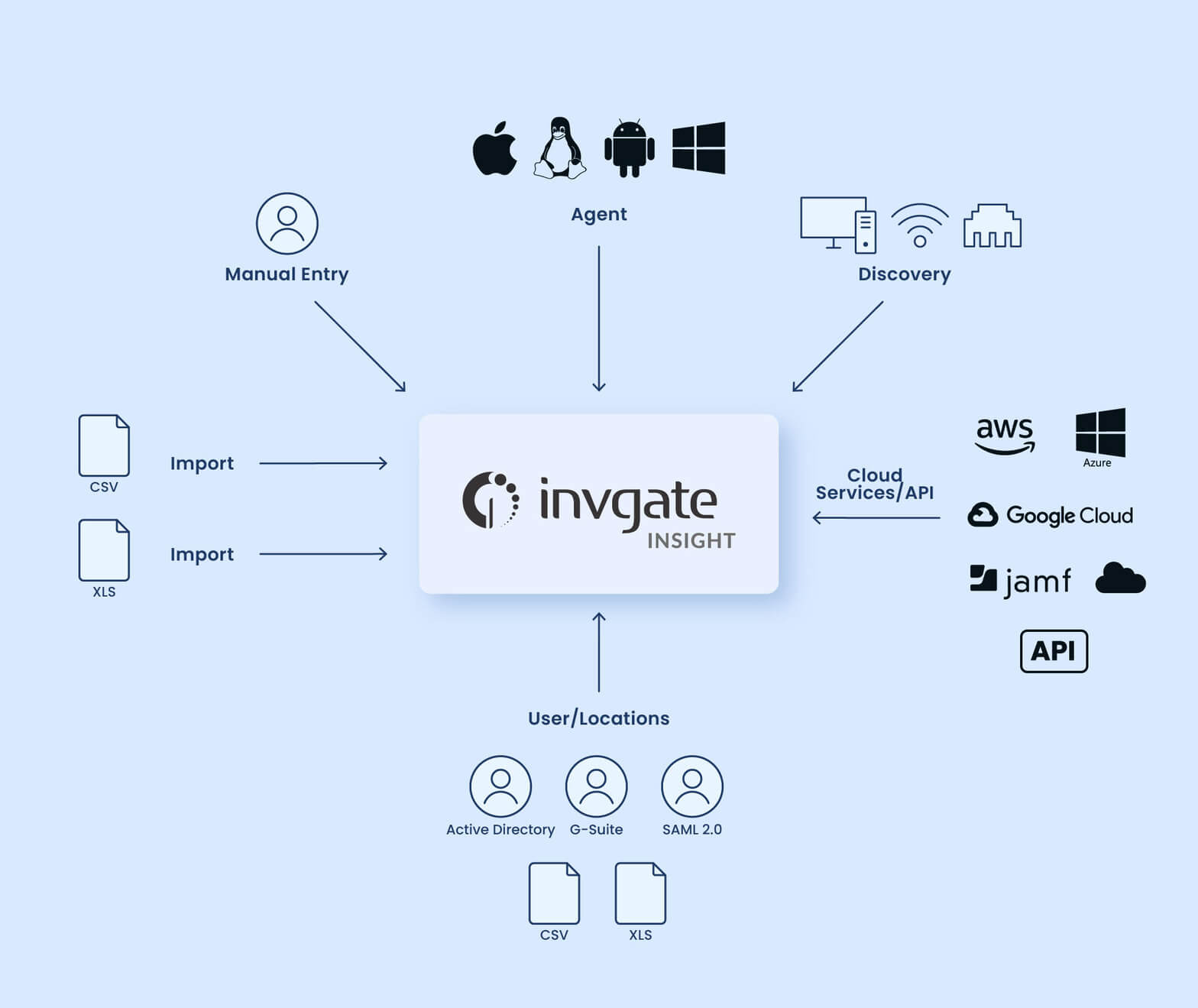
An IT Asset Management platform worthy of its name has to provide users with a complete IT inventory and multiple ways to populate it (such as an agent, a Network Discovery feature, cloud synchronization, and file upload).
2. Software Management
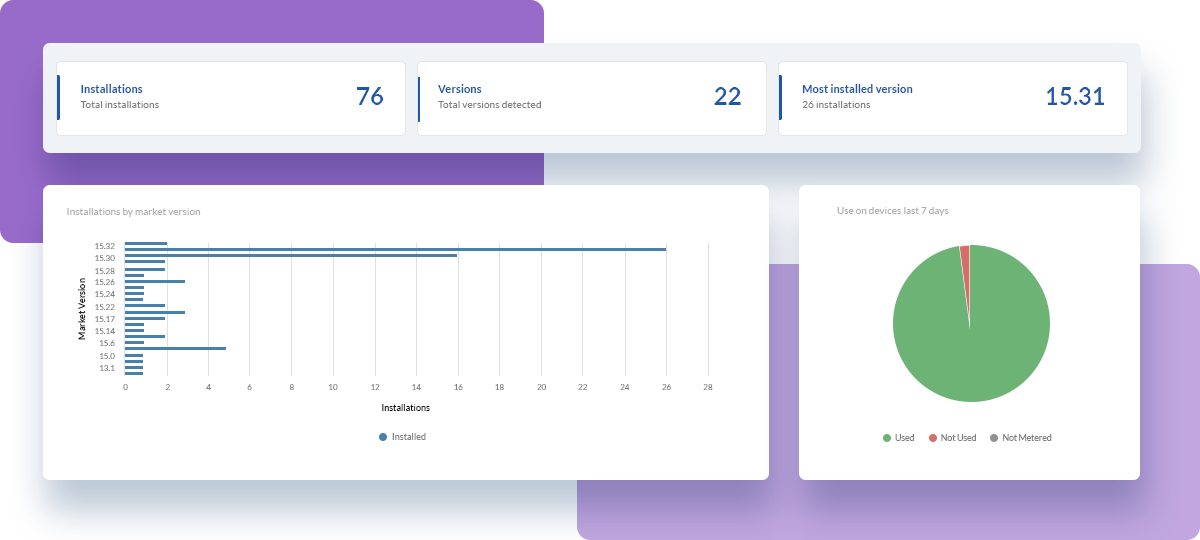
It also must offer you multiple functionalities related to SAM. For instance, software metering to understand how much your licenses are being used and software deployment to install and update software remotely.
3. CMDB
A CMDB is another must-have feature to see how your IT assets are related visually, what can be affected in case of downtime, and improve your organization’s security and compliance requirements.
4. Automation

Automation is another thing you cannot lack in today’s world. As complex as it may seem to do IT Asset Management, automation makes everything better and more straightforward. It lets you know your assets’ health, contract expiration, and more.
5. Reporting

Having software that not only compiles your asset data but also organizes it comprehensively will save you countless hours of work. Our advice is to search for tools that offer customizable dashboards and automated reports.
6. Integration with ITSM tools
Finally, and if you want to increase your ITAM software ROI even more, make sure it integrates seamlessly with your service desk (if the integration is native, even better!). By doing so, your agents will have all the asset information they need to solve a request embedded in the ticket, and you will be able to create complete workflows that trigger actions in your ITAM tool from the help desk.
Implementing an ITAM strategy with InvGate Asset Management
Although IT Asset Management can seem daunting, two things will make its implementation seamless: a solid strategy and a robust solution.
So, if you develop the former, we have you covered with the latter! InvGate Asset Management has all the features listed above to help you:
- Organize your IT inventory in just 24 hours.
- Manage your assets from purchase to disposal.
- Help you be prepared for software audits.
Plus, its user-friendly interface makes the implementation quick and smooth, increasing the adoption rates of your team.
And, of course, it integrates natively with InvGate Service Management so that your agents can benefit from having a centralized platform to see assets’ data within a ticket and trigger actions on Asset Management from the Service Management’s workflows.
If you want to explore how Asset Management can help your organization, request a 30-day free trial!
IT Asset Management best practices
Our last stop before we finish aims to provide you with some ITAM best practices to make its implementation much easier.
When developing your plan, make sure to remember the following:
- "Start where you are" - We borrowed this one from ITIL 4’s seven guiding principles. There’s no need to start from scratch; you likely already have something to leverage, like an Excel or Google Sheets list of hardware or some asset details recorded by the IT service desk or a network scanning tool.
- Target quick wins - For example, identifying underused assets for redistribution or issues with your organization’s leavers procedures.
- Train your IT asset managers in best practices - Ensure they understand ITAM’s relevance and their role in ensuring its success. It wouldn’t be a bad idea to encourage them to be certified in IT Asset Management, too.
In conclusion
Nowadays, it’s impossible to run a business without IT assets. Thus, you must manage them consciously and proactively. And IT Asset Management allows you to do exactly that.
Implementing an ITAM strategy is the best way to ensure your business:
- Doesn’t waste money on unnecessary resources.
- Allocates software and hardware assets wisely.
- Has a secure network with patched devices.
- Stays compliant with industry and audit requirements.
- Bases its decisions on trustable data and insights.
For quite some time now, ITAM has become an indispensable practice for all organizations, regardless of their size, location, or industry. If you haven’t yet explored its possibilities, here’s all the information you need to begin!
Need some extra help? You can always ask our experts what the best approach for your organization is!
